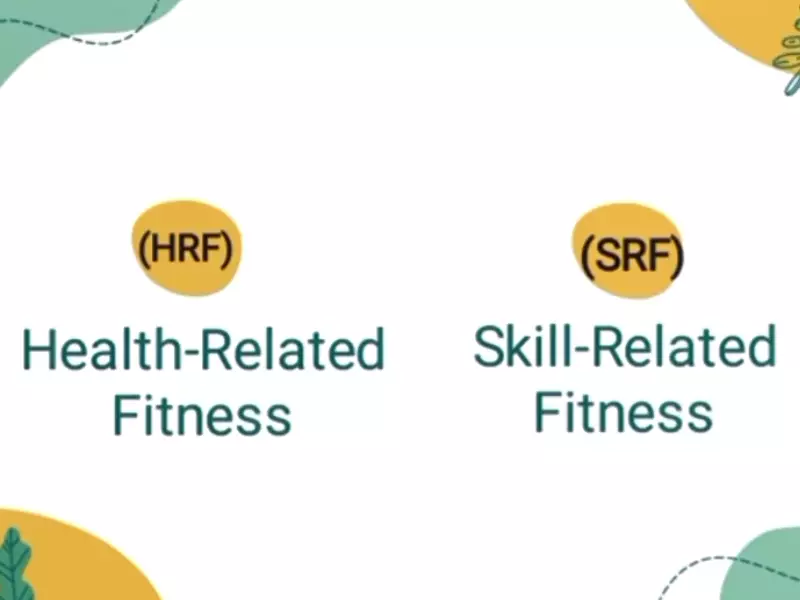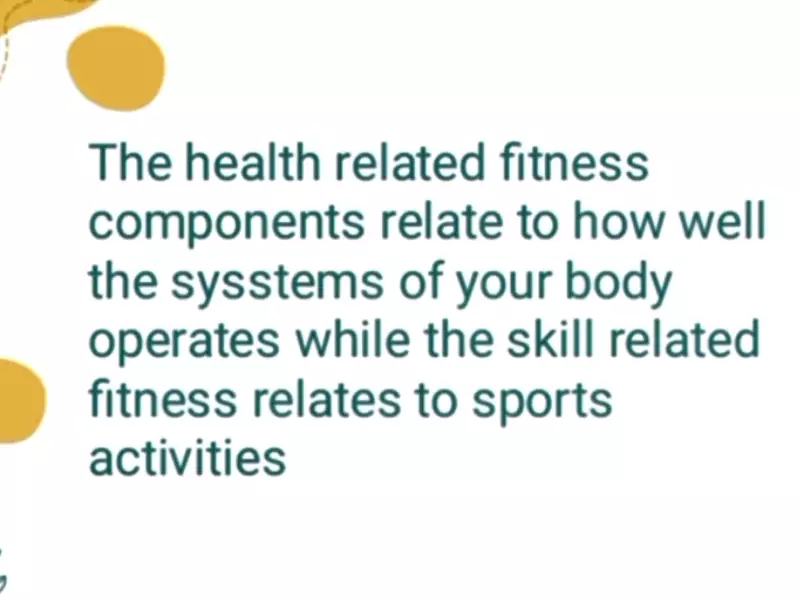Fitness encompasses a broad spectrum of physical capabilities, each catering to different aspects of well-being and performance. At its core, fitness is about more than just the ability to run long distances or lift heavy weights; it’s about nurturing a body that’s capable, resilient, and healthy. This distinction brings to light two primary categories: health-related fitness and skill-related fitness, each playing a pivotal role in overall health and physical aptitude.
The difference between health-related fitness and skill-related fitness lies in their objectives and applications. Health-related fitness focuses on improving overall health and well-being, encompassing cardiovascular endurance, muscular strength and endurance, flexibility, and body composition. On the other hand, skill-related fitness targets enhancing physical abilities directly related to sports and activities, including agility, balance, coordination, power, reaction time, and speed.
Understanding these differences is crucial for anyone looking to improve their physical health or enhance their performance in specific activities. By recognizing the unique characteristics and benefits of each fitness type, individuals can tailor their exercise routines to meet their health goals and performance aspirations, ensuring a balanced approach to fitness that nurtures both health and skill.

Fitness Fundamentals
Health-Related Components
Cardiovascular Endurance
Cardiovascular endurance is the ability of your heart, lungs, and blood vessels to deliver oxygen to your body tissues during prolonged physical activity. High cardiovascular endurance means you can perform activities like running, swimming, or cycling for extended periods without excessive fatigue. To improve it, focus on aerobic exercises such as jogging, swimming, and cycling.
Muscular Strength
Muscular strength refers to the maximum amount of force a muscle or muscle group can exert in a single effort. This component is crucial for daily tasks, sports, and injury prevention. Weightlifting and resistance training are effective methods to enhance muscular strength, targeting different muscle groups for balanced development.
Muscular Endurance
Muscular endurance is the ability of your muscles to perform repeated contractions over time without tiring. It plays a vital role in almost every athletic endeavor and daily activities. To boost your muscular endurance, incorporate low-weight and high-repetition resistance training, along with circuit training.
Flexibility
Flexibility is the range of motion available at a joint. It helps in performing movements with the maximum possible amplitude, reducing the risk of injuries. Stretching exercises, including static, dynamic, and PNF stretching, are beneficial in improving flexibility.
Body Composition
Body composition measures the proportion of fat and non-fat mass in your body. A healthy body composition is an important health indicator. Achieving and maintaining a healthy body composition involves a combination of balanced diet, regular aerobic exercise, and strength training.
Skill-Related Components
Agility
Agility is the ability to move quickly and change direction with ease. It’s essential in sports that require quick transitions. Agility ladder drills and cone drills can significantly improve your agility.
Balance
Balance is the ability to maintain the body’s center of mass over its base of support. Yoga and Pilates are excellent for enhancing balance, as well as exercises like standing on one leg or using a balance board.
Coordination
Coordination is the ability to use different parts of the body together smoothly and efficiently. To improve coordination, try activities that require precise movements, such as dancing, juggling, or playing catch.
Power
Power is the ability to exert maximum force in minimal time. It’s crucial in sports that require explosive movements. Plyometric exercises, such as jump squats and box jumps, are effective in increasing power.
Reaction Time
Reaction time is the time taken to respond to a stimulus. Fast-paced sports, video games, and reaction time drills can help improve your reaction time, enhancing your performance in various sports and activities.
Speed
Speed is the ability to move quickly across the ground or move limbs rapidly to grab or throw. Sprints and interval training are effective methods to increase your speed, improving overall athletic performance.
Comparing Health and Skill Fitness
Core Differences
Objectives
The primary objective of health-related fitness is to enhance overall health and prevent diseases, while skill-related fitness focuses on improving performance in sports and activities.
Measurements
Health-related fitness is measured through components like body composition and cardiovascular endurance, whereas skill-related fitness is assessed through agility, balance, and coordination among others.
Training Methods
Training for health-related fitness often involves aerobic exercises, strength training, and flexibility routines. Skill-related fitness, on the other hand, requires specific drills and practices focusing on agility, balance, and power.
Impact on Daily Life
Health-Related Benefits
Health-related fitness improves quality of life by reducing the risk of chronic diseases, enhancing mood, and increasing energy levels. It’s fundamental for longevity and overall well-being.
Skill-Related Benefits
Skill-related fitness enhances physical performance, making it easier to perform daily tasks, improve sports performance, and reduce the risk of injuries.
Training for Health vs. Skill
Health-Focused Training
Aerobic Exercises
- Jogging
- Swimming
- Cycling
Strength Training
- Weightlifting
- Resistance bands
Flexibility Routines
- Static stretching
- Dynamic stretching
Skill-Focused Training
Drills for Agility
- Ladder drills
- Cone drills
Balance Exercises
- Yoga poses
- Pilates
Coordination Challenges
- Dance routines
- Juggling

Integrating Both Fitness Types
Balanced Approach
Achieving a balanced fitness regimen involves incorporating elements of both health-related and skill-related fitness. This holistic approach ensures comprehensive benefits, enhancing not just physical health but also athletic performance. A balanced fitness program caters to all aspects of fitness, promoting cardiovascular health, muscle strength, flexibility, agility, and coordination.
Key Components for Integration
- Routine Variety: Incorporate a mix of aerobic, strength, flexibility, and skill-based exercises.
- Consistency and Progression: Gradually increase the intensity and complexity of workouts to challenge the body and prevent plateaus.
- Recovery and Nutrition: Emphasize proper recovery through rest days and nutrition to support fitness gains and overall health.
Examples of Integrated Training
Example Routine for a Week
- Monday: Cardiovascular training (e.g., running) + Agility drills
- Wednesday: Strength training (full body) + Balance exercises (yoga)
- Friday: High-Intensity Interval Training (HIIT) for both aerobic and anaerobic benefits + Coordination drills (e.g., dance or martial arts)
- Sunday: Active recovery with flexibility routines (stretching or Pilates)
This routine showcases how different fitness components can be seamlessly integrated into a weekly plan, offering a balanced approach to fitness that caters to both health and skill development.
Choosing Your Focus
Personal Goals
Identifying your personal fitness goals is crucial in determining the emphasis of your training. Goals vary widely among individuals, from losing weight and improving health markers to excelling in a specific sport or activity.
- Health-Oriented Goals: If your primary aim is to improve health, focus more on cardiovascular endurance, muscular strength, and flexibility. These components are key to reducing health risks and enhancing the quality of life.
- Performance-Oriented Goals: For those aiming to improve in a specific sport or activity, skill-related fitness components like agility, balance, and coordination become more crucial. Tailor your training to the demands of your chosen activity.
Professional Requirements
For some, fitness goals are aligned with professional requirements. Athletes, dancers, and individuals in physically demanding professions need to maintain both health-related and skill-related fitness at optimal levels.
- Athletes: Must balance health-related fitness to prevent injuries and maintain overall health with skill-related fitness to excel in their sports.
- First Responders and Military Personnel: Require a high level of fitness for both health and performance, necessitating a training regimen that enhances strength, endurance, agility, and coordination.
Strategies for Personalizing Your Fitness Plan
- Assess Your Current Fitness Level: Understanding where you stand in terms of both health-related and skill-related fitness components will guide the initial setup of your plan.
- Set Clear, Achievable Goals: Whether they’re health improvements, weight loss, or performance in a sport, having clear goals will dictate the structure of your training.
- Consult with Fitness Professionals: A personal trainer or coach can provide valuable insights into integrating various fitness components tailored to your needs and goals.
- Monitor and Adjust Your Plan Regularly: Regularly assess your progress towards your goals and adjust your training plan as needed to ensure continued improvement and motivation.
Frequently Asked Questions
What is health-related fitness?
Health-related fitness refers to physical capacities that contribute to overall health and the prevention of chronic diseases. It includes cardiovascular endurance, muscular strength and endurance, flexibility, and body composition. The goal is to maintain or improve heart health, muscular strength, body flexibility, and achieve a healthy body weight.
How does skill-related fitness differ from health-related fitness?
Skill-related fitness focuses on improving abilities that enhance performance in sports and physical activities. It includes agility, balance, coordination, power, reaction time, and speed. Unlike health-related fitness, which aims at overall well-being, skill-related fitness targets specific physical capabilities to improve performance in sports or activities requiring particular skills.
Can someone focus on both health-related and skill-related fitness at the same time?
Absolutely. Integrating both health-related and skill-related fitness into a training regimen can lead to a well-rounded physical condition. While health-related fitness enhances overall well-being and prevents chronic diseases, skill-related fitness hones specific physical abilities. A balanced approach to training that includes aspects of both fitness types can maximize health benefits and performance capabilities.
Why is flexibility considered a part of health-related fitness?
Flexibility is vital for overall health because it improves joint range of motion, reduces the risk of injuries, and enhances muscle coordination. Being a component of health-related fitness, it contributes to better posture, reduced muscle soreness, and improved physical performance. Regular flexibility exercises are essential for maintaining a healthy and functional body.
Conclusion
The distinction between health-related fitness and skill-related fitness is not just academic; it’s a practical guide for tailoring your fitness journey. Whether your goal is to enhance your general health, excel in a specific sport, or both, understanding these categories enables you to design a workout regimen that aligns with your objectives. By focusing on the areas most relevant to your goals, you can create a balanced, effective approach to fitness.
Ultimately, the journey to fitness is personal and multifaceted, encompassing a broad range of physical capabilities and goals. Embracing both health-related and skill-related components can lead to a more balanced, healthier lifestyle that supports both long-term well-being and specific skill development. The key is to recognize your personal fitness objectives and to craft a regimen that addresses both your health and performance aspirations.
